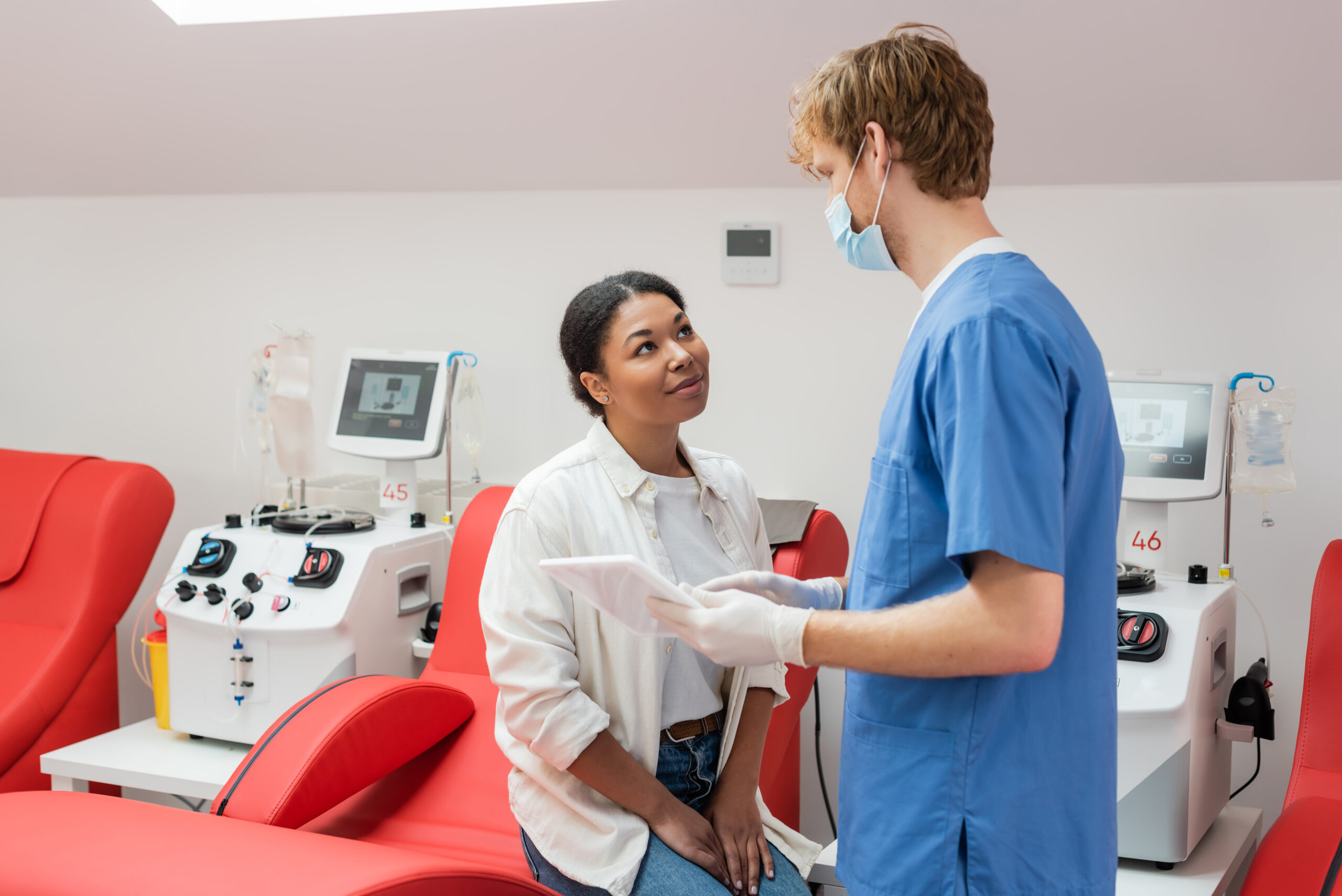When it comes to sexual health, timely action makes the difference in outcomes, but many individuals are left unsure about when and how to seek emergency care for sexually transmitted diseases (STDs). Knowing when to go to the emergency room (ER) or exploring other healthcare services for testing can be daunting, especially if symptoms arise unexpectedly.
The symptoms of STDs can vary widely, from mild discomfort to severe health challenges, leading to confusion about the best course of action. Understanding the urgency of your symptoms, along with the services offered in different healthcare settings, is crucial for making informed decisions about your health.
In this article, we’ll delve into the critical considerations around visiting the ER for STD symptoms, discuss alternative testing options, and highlight preventive measures and treatment strategies. With the right information, you can confidently navigate your sexual health and make the best choice for your situation.
Common Symptoms of STDs That Require Immediate Attention
When it comes to sexual health, early recognition of STD symptoms is crucial. Here are some common symptoms that require immediate attention:
- Pain and Discomfort: Burning sensations during urination or intercourse may signal infections like chlamydia or gonorrhea.
- Unusual Discharge: Any unusual discharge, either from the genitals or rectum, deserves a healthcare professional’s examination.
- Rashes and Blisters: Genital herpes infection or syphilis can cause blisters, sores, or rashes. These require prompt medical care.
- Genital Warts: These growths can be a symptom of human papillomavirus (HPV), requiring attention to prevent spreading.
- Pelvic Pain: Persistent pelvic pain might indicate pelvic inflammatory disease, a result of untreated STDs.
- Swelling: Swelling in the groin or genitals may indicate an infection that requires diagnostic tests.
Addressing these symptoms swiftly can safeguard your health and prevent further complications. Regular tests and communication with sexual partners are vital in managing sexual health. Be proactive and consult with a healthcare provider if you notice any unusual signs.
Expectations When Visiting the ER for STD Testing
Knowing what to expect before going for testing may help ease the nerves of someone unfamiliar with the process. When visiting the ER for STD testing, there are several points to keep in mind.
Typically, testing involves collecting urine samples, blood samples, or swabs for accurate testing. ER doctors can test for various STDs, including genital herpes and genital warts, and identify symptoms of STDs.
You can expect rapid testing in some cases, though results may take longer if in-depth diagnostic tests are required. Healthcare professionals will ask about your sexual activity and risk factors, including the number of sexual partners and any symptoms you’re experiencing, especially if you have multiple partners.
Consider the following:
- Severe emergencies might delay STD diagnosis when testing at an ER.
- Be ready to discuss recent sexual contact.
- Testing methods might include urine, blood, or swabs.
- Rapid tests may be available but not guaranteed.
It’s important to note that emergency room visits can be costly without health insurance. Consider regular tests through primary care physicians for ongoing sexual health management.
Available Diagnostic Tests in Emergency Rooms
Emergency rooms primary role is addressing with medical emergencies. However, they also offer diagnostic tests for various conditions, including sexually transmitted diseases (STDs). If you’re experiencing acute symptoms that you believe to be STD-related, the ER can be a viable option for initial testing. This is particularly important if you cannot access other healthcare facilities, such as primary care physicians or urgent care centers, for a thorough physical exam.
Types of Diagnostic Tests Available in ERs:
- Urine Samples: Used for detecting infections like chlamydia and gonorrhea.
- Blood Samples: Essential for identifying diseases such as HIV and syphilis.
- Rapid Tests: Quickly give preliminary results, which can be crucial for timely treatment.
- Physical Examinations: Visual checks for symptoms, such as genital warts or herpes.
ERs are equipped for rapid testing, enabling healthcare professionals to address true emergencies swiftly. While they can offer accurate testing in urgent situations, ER visits should not replace regular STD screenings. For regular monitoring or in non-emergency situations, visiting primary care physicians or urgent care centers is advisable. Always consult healthcare professionals to understand the risk factors and determine the most appropriate diagnostic tests.
Cost of STD Testing in the Emergency Room
The cost of STD testing in the ER can be high, often exceeding those at other care facilities. Emergency departments focus on immediate and urgent medical issues, which may result in additional fees. Prices vary depending on several factors including hospital location, the type of test required, and whether you have health insurance.
For instance, an ER visit can range anywhere from $150 to over $1,000, and the std test cost can add another $50 to $200 per test. Blood and urine samples for testing can further raise these costs.
Health insurance might cover some of these expenses, but coverage depends on your specific plan. It’s important to check with your insurance provider about STD testing coverage.
If cost is a concern, consider visiting urgent care centers or primary care physicians. These alternatives could offer more affordable options for sexual health needs. Regular tests or rapid tests at these facilities are typically more cost-effective and accessible for meeting sexual health screening needs.
Comparing STD Testing Options
Testing for sexually transmitted diseases (STDs) is a crucial part of maintaining your health, and choosing the right std test method helps prevent the spread of infections and protects both you and your sexual partners. But where should you go for STD testing? Several options are available, each with its pros and cons. Below, we compare the three other options: urgent care centers, private practices, and online test ordering.
Urgent Care Centers
Urgent care centers are a practical choice for STD testing. They’re convenient and generally provide affordable services without the need for appointments. Urgent care services are excellent for non-emergency situations where you need medical care fast. They can be less overwhelming than a hospital’s emergency department and often allow for a quicker turnaround in test results.
Urgent care facilities perform STD tests using urine and blood samples. They provide accurate testing for common STDs like chlamydia, gonorrhea, and syphilis. Most centers have healthcare professionals on-site who can assist with questions about symptoms, risk factors, and treatments for sexual health issues.
Costs at urgent care are generally lower than in emergency rooms, and rapid STD tests can be available. This makes urgent care centers an excellent choice for timely and cost-effective testing, especially for sexually active individuals seeking regular tests.
Private Practice
Primary care physicians in private practice can also offer STD testing. This option often provides the added benefit of a more personalized approach to sexual health. Your doctor knows your medical history, which can be valuable for diagnosing symptoms of STDs or related health conditions like urinary tract infections or inflammatory diseases.
Scheduling an appointment may be necessary for private practice. This allows for more in-depth consultations about sexual activity and overall health. Costs may vary, but having health insurance can significantly reduce the expense of testing in a private setting.
The patient-physician relationship can lead to stress-free discussions about sexual health. However, it may take longer to receive test results compared to rapid STD tests.
Online Test Ordering
For individuals seeking privacy and convenience, online test ordering is a viable option. Tests are ordered online, and sample collection kits are sent directly to your home. This method allows you to collect your samples—blood or urine—privately and mail them back to a lab for analysis.
While online testing can offer a discreet option, it may lack the immediate healthcare professional interaction provided by urgent care services or private practice. However, online platforms often have customer support for questions about the testing process.
Some online services provide rapid testing options, delivering results faster than traditional testing routes. Pricing may vary, but they often offer testing packages that cover multiple STDs, making them a cost-effective option for routine checks.
In conclusion, your choice of STD testing method depends on your priorities. Emergency room visits are ideal for immediate, serious symptoms but are more costly. Urgent care centers balance efficiency, cost, and availability for less critical needs. A private practice offers personalized care, while online test ordering provides maximum privacy and convenience. Determine what matters most to you and choose accordingly.
Benefits of Emergency Room Testing
Emergency rooms (ERs) provide critical medical care during urgent situations. One benefit of ER testing is the immediate attention to sexually transmitted diseases (STDs). This is particularly important during true emergencies when symptoms like severe pain or high fever can’t wait for regular tests at a clinic.
ERs often have access to rapid testing, which offers quick results for conditions like genital herpes or other sexually transmitted infections (STIs). Rapid tests use blood or urine samples, allowing healthcare professionals to swiftly decide on necessary treatment. This approach prevents complications such as inflammatory disease, which can arise from untreated infections.
Another advantage is the availability of comprehensive diagnostic tests. These tests help to identify symptoms of STDs accurately and ensure appropriate medical care. For those worried about health issues, this can alleviate anxiety and provide peace of mind.
Though the ER is not the first choice for regular STD testing, it can be vital for those without access to primary care physicians or urgent care centers. Individuals can receive immediate support and follow-up recommendations as required.
Limitations of Emergency Room Testing
When it comes to testing for sexually transmitted diseases (STDs), ERs have some limitations. While ERs can perform tests for STDs, they are generally not the best place for non-emergency sexual health issues.
The primary focus of emergency departments is to treat urgent and life-threatening conditions. Therefore, they may not perform comprehensive STD screenings. Instead, their STD testing services often aim at addressing immediate symptoms, such as those resembling urinary tract infections or inflammatory diseases.
Moreover, the testing process in an ER may involve taking urine or blood samples, but these tests might not always be as thorough as those offered by primary care physicians or specialized urgent care centers. Accuracy and quick results can be inconsistent due to the busy nature of ERs.
Patients attending ERs for STD concerns may often face longer wait times and higher costs compared to visiting urgent care facilities or sexual health clinics, which are better equipped for rapid and regular tests. While ERs can provide some support, they should not replace regular check-ups with healthcare professionals for maintaining sexual health.
Preventive Measures for STDs
Sexually transmitted diseases (STDs) are a significant public health issue. However, there are effective ways to prevent them. Here are some key measures:
- Use Protection: Always use condoms during sexual activity to reduce the risk of transmitting most STDs, especially if you’ve previously practiced unprotected sex.
- Vaccination: Certain vaccines, such as those for HPV (human papillomavirus) and hepatitis B, can prevent these diseases. Discuss vaccination options with a healthcare professional.
- Limit Sexual Partners: Having fewer sexual partners can decrease the chance of contracting STDs. It’s vital to maintain mutual monogamy.
- Get Tested Regularly: Regular testing ensures early detection and treatment. Encourage your partners to get tested, too.
- Practice Abstinence: The only way to avoid STDs entirely is to abstain from sexual contact. If not practical, consider other preventive measures.
- Educate Yourself and Others: Stay informed about symptoms of STDs and preventive strategies. Share this knowledge with others to promote sexual health.
By following these preventive measures, individuals can significantly reduce their risk of encountering STDs, thus ensuring their sexual health.
Treatment Options for STDs
Sexually transmitted diseases require prompt attention and treatment to prevent complications. The treatment options vary depending on the specific type of STD.
- Antibiotics: Bacterial STDs like chlamydia, gonorrhea, and syphilis can be treated with antibiotics. A healthcare professional will prescribe a course of antibiotics that must be completed even if symptoms improve.
- Antiviral Medications: For viral STDs such as genital herpes and HIV, antiviral medications help manage symptoms and reduce transmission risk. While these cannot cure the infection, they can effectively control outbreaks and improve quality of life.
- Vaccinations: Vaccines can prevent STDs such as human papillomavirus (HPV) and hepatitis B. It’s advisable to get vaccinated before becoming sexually active.
- Topical Treatments: Genital warts, caused by certain strains of HPV, can be treated with topical medications or procedures to remove warts.
- Partner Notification and Treatment: It’s crucial to inform sexual partners about an STD diagnosis so they can also seek treatment to prevent reinfection.
Early diagnosis and treatment can mitigate health issues and reduce the spread of STDs, and understanding the std test cost can help in planning for regular check-ups. Maintaining regular check-ups and practicing safe sexual activity is essential for sexual health.
For more information on STD treatment options, consult with a healthcare professional.
Conclusion: When to Seek Emergency Care for STDs
Emergency rooms are equipped to handle a wide range of medical issues, including STD testing. However, visiting an emergency room should be reserved for urgent situations due to its costs and lack of readily-available treatment.
If you’re wondering when it is advisable to visit an ER for STD care, here are a few scenarios that may warrant a trip to the ER:
- Severe Symptoms: If experiencing intense pain, fever, or unusual discharge, consider the ER. These could be signs of an advanced STD or another infection needing immediate attention.
- Genital Warts or Herpes Outbreaks: For severe outbreaks causing significant pain or dysfunction, emergency care is appropriate.
- Possible Pregnancy Complications: If you suspect an STD during pregnancy, it’s crucial to seek care immediately to protect both mother and child.
- Unprotected Sexual Contact with Symptoms: Following exposure with severe symptoms, rapid testing at the ER can be necessary.
While the ER can perform accurate testing and provide immediate care, regular check-ups and testing through primary care or urgent care facilities are recommended for non-emergencies. Understanding when to seek emergency care ensures better management of your sexual health.
FAQs
Can I go to the ER if I think I have an STD?
Yes, you can go to the emergency room if you suspect you have a sexually transmitted disease (STD), especially if you’re experiencing severe symptoms that require immediate attention. While emergency rooms can provide STD testing and treatment, they are primarily designed to handle urgent and life-threatening conditions. If your symptoms include intense pain, fever, or unusual discharge, a visit to the ER may be necessary to rule out serious complications or infections.
However, for non-emergency situations, consider visiting urgent care centers or consulting with a primary care physician. These healthcare settings are often more cost-effective and can provide comprehensive STD screenings and follow-up care. Regular tests and communication with healthcare professionals are crucial for maintaining sexual health and preventing the spread of infections.
Does an ER blood test Show STDs?
Emergency rooms can conduct blood tests to detect certain sexually transmitted diseases. Blood tests in the ER are typically used to identify infections such as HIV and syphilis. These tests are crucial when symptoms are severe or when immediate diagnosis is necessary to prevent complications.
However, not all STDs can be detected through a blood test. Infections like chlamydia and gonorrhea usually require urine samples or swabs for accurate testing. The ER may prioritize immediate health concerns, so comprehensive STD screenings might not be available in this setting. Again, gauge the severity of your symptoms to make an informed decision on where to undergo testing.
For thorough STD testing, including those requiring specialized tests, consulting with a primary care physician or visiting an urgent care facility may be more appropriate. These healthcare providers can offer a broader range of tests and follow-up care to ensure comprehensive sexual health management.
Can the ER do a rapid STD testing?
Yes, ERs can perform rapid STD tests. Availability of such tests may vary depending on the facility, but rapid testing is beneficial in emergency settings where immediate diagnosis and treatment are crucial. These tests can quickly identify certain sexually transmitted diseases, such as HIV and syphilis, using blood samples or other methods.
It’s important to note that while rapid tests provide quick results, they might not be as comprehensive as those conducted in other clinical settings, such as primary care physicians or urgent care facilities. For a thorough STD screening, which may include tests for infections like chlamydia and gonorrhea, additional samples like urine or swabs might be needed.
Can an STD be treated in an emergency room?
Yes, sexually transmitted diseases (STDs) can be treated in an emergency room, especially if you’re experiencing severe symptoms that require immediate medical attention. Emergency rooms are equipped to handle urgent health issues and can provide initial treatment for STDs, such as administering antibiotics for bacterial infections like chlamydia or gonorrhea.
While ERs can address acute symptoms and complications, they are not typically the best setting for comprehensive STD care or routine screenings. For ongoing management and follow-up care, visiting a primary care physician or an urgent care facility is advisable. These healthcare providers can offer a more thorough evaluation, regular tests, and personalized STD treatment plans, ensuring your sexual health is effectively managed.
Sources:
- CDC, “STDs & Pregnancy: Preterm labor risk & testing,”https://www.cdc.gov/sti/about/about-stis-and-pregnancy.html
- American Sexual Health Association
- CDC STD Prevention: https://www.cdc.gov/sti/prevention/index.html
- Mayo Clinic: https://www.mayoclinic.org/diseases-conditions/sexually-transmitted-diseases-stds/in-depth/std-testing/art-20046019






